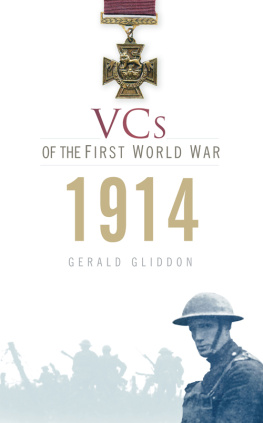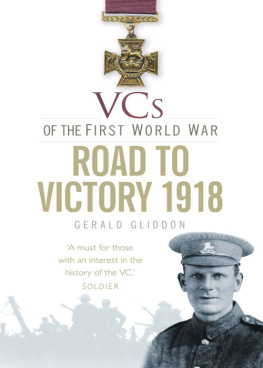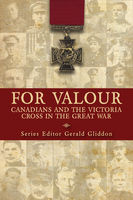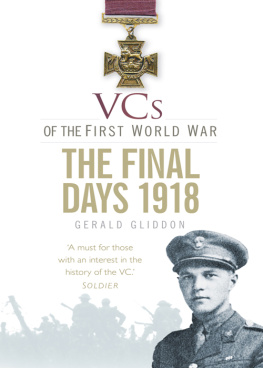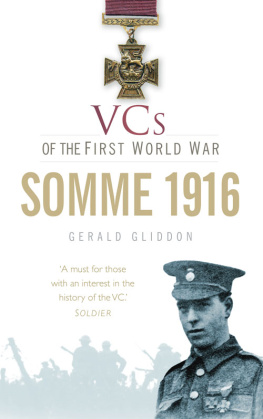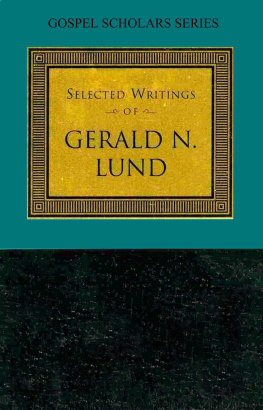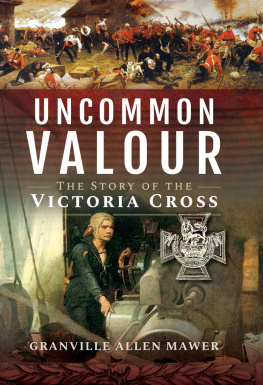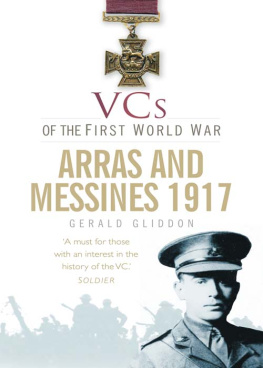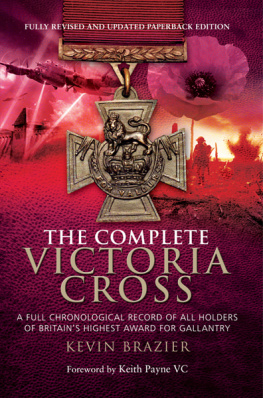
I would like to thank the staff at the following institutions for their help and patience during the research for this book: The Commonwealth War Graves Commission, the Imperial War Museum, London, the National Army Museum, London, the National Archives, Kew, the Royal Artillery Institution, London, and the Royal Engineers Museum, Chatham, Kent.
Illustrations have been obtained from the following: D. Ascoli, The Mons Star , pp. 3, 47, 103, 177, 192; The Bugle , p. 61; the Cheyne family, picture section p. 10; A. Fullaway, picture section p. 15; The Illustrated London News , picture section pp. 5, 4 (top), 7 (top), 11 (top); Illustrated Michelin Guide, Ypres and the Battles of Ypres , p. 148; Charlie McDonald, picture section p. 15 (top right); David Rowlands, picture section p. 2 (top); Michelle Young, picture section p. 14 (top right).
I have also received considerable assistance from the following individuals who have all helped in various ways: Peter Batchelor, John Bolton, Tom Brophy, John Cameron, Jack Cavanagh, Colonel Terry Cave CBE, Peter Harris, Donald C. Jennings, Maurice Johnson, Dennis Pillinger, Joan Purcell, David Rowlands, Steve Snelling, the late Tony Spagnoly and Andrew Vollans. My wife Wynne has, as always, been a great support.
C ONTENTS
After the publication of Vcs of the First World War: The Somme it occurred to me that it would be a good idea to produce other books on some of the 634 men who won the Victoria Cross in the First World War. 1914 is therefore the second volume in the series to be published.
I began my VCs of the First World War: 1914 research with the files of the late Canon Lummis (who was with the Cavalry in 1914 and who built up a filing system that dealt with all winners of the VC) that are cared for by the Military Historical Society and are housed at the National Army Museum in London. A similar set of files with supplementary material is kept at the Department of Printed Documents at the Imperial War Museum. Any would-be researcher should inspect both sets of files.
I wrote to all the Regimental archives kept by the various units, where they still existed, and to many local newspapers throughout the British Isles. Response to these requests was uneven but occasionally very fruitful indeed. I visited various museums including the Royal Artillery Institution who have individual files on the artillerymen who won the Victoria Cross in the First World War. I also visited the National Archives at Kew but the majority of the researching there was carried out most efficiently by Maurice Johnson.
As for the illustrations I have once again used the famous Gallahers Cigarette Card set and also many artists impressions, mostly from the book Deeds that Thrilled the Empire . These pictures are by no means always accurate but do give a feeling of the period and also depict attitudes that prevailed at the time. Most of the other photographs have been taken in recent years and I have been able to secure pictures of the graves of all the men where they exist. During this research I have once again been able to draw on the considerable kindness of Mr D.C. Jennings who lives in Florida, USA.
I have been unable to commission a brand new set of maps and have, therefore, reproduced some of the ones first used by David Ascoli in his book The Mons Star and also some of the maps used in the Michelin Guide to Ypres .
Lastly I have attempted to read as many published accounts of the Deeds as possible. Some of these are listed in the Bibliography.
ASH | Argyll & Sutherland Highlanders |
BEF | British Expeditionary Force |
BWM | British War Medal |
BSM | Battery Sergeant Major |
CB | Commander of the Bath |
CG | Coldstream Guards |
CRA | Commander Royal Artillery |
CRE | Commander Royal Engineers |
CCS | Casualty Clearing Station |
DCLI | Duke of Cornwalls Light Infantry |
DG | Dragoon Guards |
DUKES | Duke of Wellingtons (West Riding) |
GOC | General Officer Commanding |
HLI | Highland Light Infantry |
KOSB | Kings Own Scottish Borderers |
KOYLI | Kings Own Yorkshire Light Infantry |
KRRC | Kings Royal Rifle Corps |
LDV | Local Defence Volunteers |
LG | London Gazette |
MC | Military Cross |
NA | The National Archives |
NF | Northumberland Fusiliers |
OTC | Officers Training Corps |
OCA | Old Comrades Association |
OP | Observation Post |
Ox & Bucks | Oxfordshire and Buckinghamshire Light Infantry |
PO | Petty Officer |
RAMC | Royal Army Medical Corps |
RA | Royal Artillery |
RE | Royal Engineers |
RFA | Royal Field Artillery |
RFC | Royal Flying Corps |
RHA | Royal Horse Artillery |
RSF | Royal Scots Fusiliers |
RWF | Royal Welch Fusiliers |
SAA | Small Arms Ammunition |
SWB | South Wales Borderers |
TF | Territorial Force |
VC | Victoria Cross |
VM | Victory Medal |
The Victoria Cross is the most coveted decoration that can be awarded to any member of the British and Commonwealth armed services. It can also be awarded posthumously. The medal was instituted in 1856 by Queen Victoria and is made from gun metal in the design of a Maltese Cross. It measures 3.8 centimetres across. The ribbon used in 1914 was red for the army and blue for the Royal Navy and below the crown were the words For Valour . The date of the deed is inscribed on the reverse side. A small pension is paid to holders of the Cross.
The British Army was considerably altered in the period between the end of the Boer War in 1902 and the beginning of the First World War in 1914. There were lessons to be learnt and in South Africa the numerically inferior army of Boers had for much of the time out-thought and out-gunned the much larger British Army. There were also lessons to be learnt from the Russo-Japanese war of 190405. Instrumental in these changes was Lord Haldane, the War Minister, who brought in the Haldane reforms and instigated the Territorial Army in 1908. Its role was at first to be a supplementary one, in that it was to be a back-up to the regular army who in turn would call on its reservists in the event of hostilities.
The War Office had planned for the possibility of a European Campaign for some time and when it became clear that the German nation was set on invading and conquering France with the use of the Schlieffen Plan, the British Army was ready. Within less than two weeks the first troops of what were to be initially six infantry divisions and a cavalry division, together with a headquarters staff and back-up, were arriving in France and Belgium. Their role was one of support to their Belgian and French Allies.
Next page
